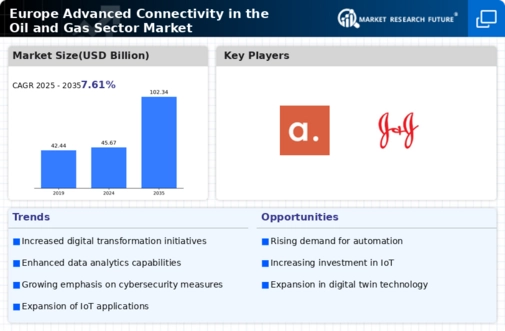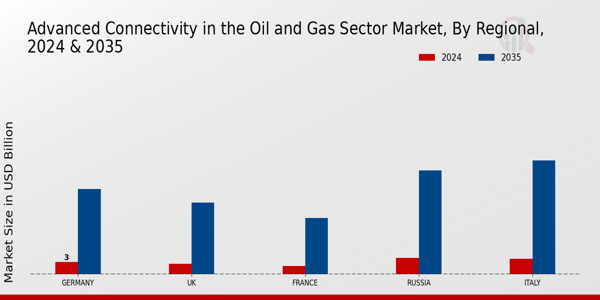Market Growth Projections
The Global Europe Advanced Connectivity in the Oil and Gas Sector Market Industry is projected to experience robust growth, with a market value anticipated to reach 102.34 USD Billion by 2035. This growth trajectory is underpinned by a compound annual growth rate of 7.61% from 2025 to 2035, reflecting the increasing adoption of advanced connectivity solutions across the sector. The market's expansion is likely driven by factors such as digital transformation, regulatory compliance, and the need for enhanced operational efficiency.
Enhanced Data Security Measures
In the context of the Global Europe Advanced Connectivity in the Oil and Gas Sector Market Industry, enhanced data security measures are becoming increasingly critical. As digital connectivity expands, the risk of cyber threats also escalates. Companies are investing in robust cybersecurity frameworks to protect sensitive operational data and ensure the integrity of their systems. This focus on security not only safeguards assets but also builds trust with stakeholders. The growing emphasis on data protection is expected to drive market growth, aligning with the anticipated CAGR of 7.61% from 2025 to 2035.
Digital Transformation Initiatives
The Global Europe Advanced Connectivity in the Oil and Gas Sector Market Industry is experiencing a surge in digital transformation initiatives. Companies are increasingly adopting advanced technologies such as IoT, AI, and big data analytics to enhance operational efficiency and decision-making processes. For instance, the integration of IoT devices allows for real-time monitoring of equipment, reducing downtime and maintenance costs. This shift is projected to contribute to the market's growth, with an estimated value of 45.67 USD Billion in 2024, as organizations strive to optimize their operations and improve safety standards.
Growing Demand for Remote Operations
The Global Europe Advanced Connectivity in the Oil and Gas Sector Market Industry is increasingly driven by the growing demand for remote operations. Companies are leveraging advanced connectivity solutions to enable remote monitoring and control of operations, which enhances efficiency and reduces operational costs. This trend is particularly relevant in offshore drilling and exploration, where remote technologies can mitigate risks associated with personnel safety. As the industry adapts to this demand, the market is poised for growth, with projections indicating a value of 102.34 USD Billion by 2035.
Investment in Infrastructure Development
The Global Europe Advanced Connectivity in the Oil and Gas Sector Market Industry is witnessing substantial investments in infrastructure development. As companies seek to modernize their operations, investments in advanced connectivity infrastructure such as high-speed networks and cloud computing are becoming paramount. This infrastructure enables seamless data exchange and enhances collaboration across various operational facets. The ongoing development efforts are expected to bolster the market's growth trajectory, contributing to a projected market value of 45.67 USD Billion in 2024, as firms prioritize technological advancements to remain competitive.
Regulatory Compliance and Environmental Standards
The Global Europe Advanced Connectivity in the Oil and Gas Sector Market Industry is significantly influenced by stringent regulatory compliance and environmental standards. Governments across Europe are implementing policies aimed at reducing carbon emissions and promoting sustainable practices. This regulatory landscape compels oil and gas companies to invest in advanced connectivity solutions that facilitate compliance monitoring and reporting. As a result, the market is likely to see increased investments, contributing to a projected market value of 102.34 USD Billion by 2035, as firms adapt to evolving environmental regulations.














Leave a Comment